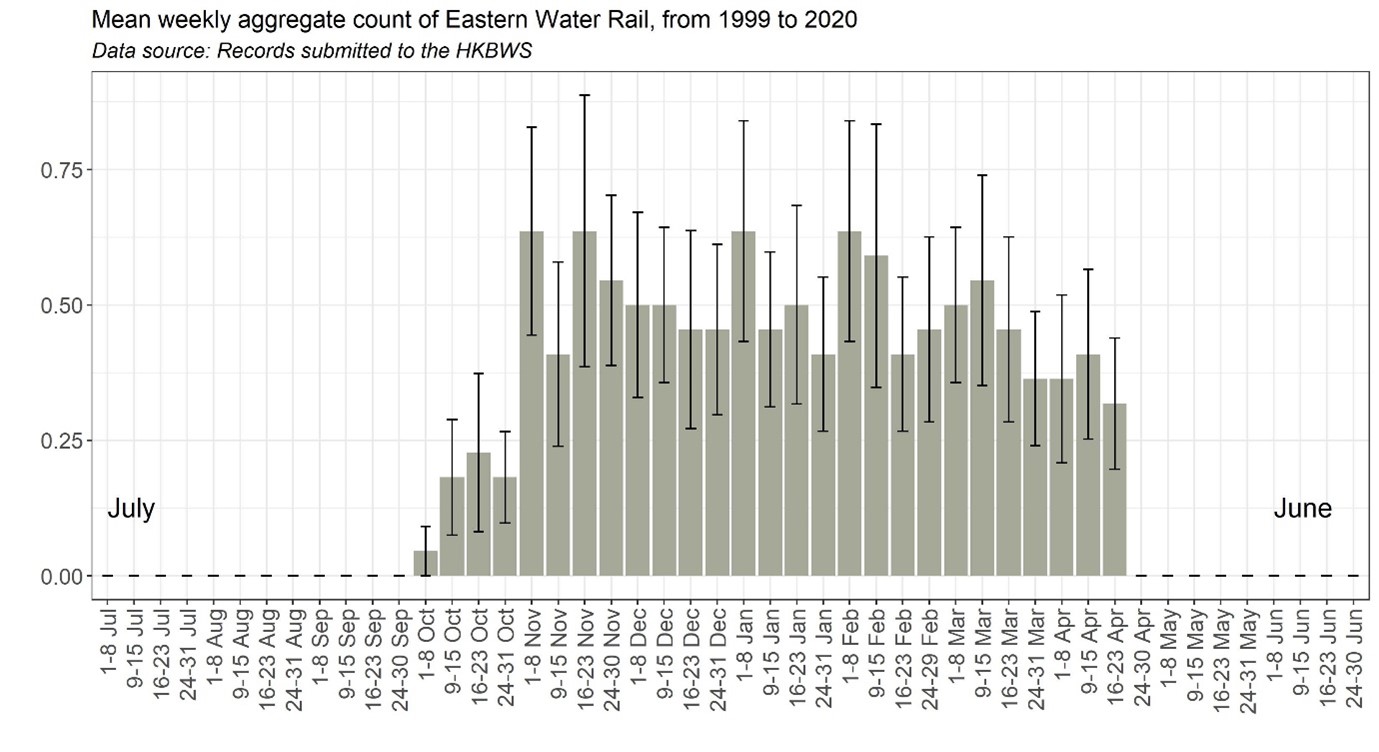Eastern Water Rail Rallus indicus 普通秧雞
Category I. Scarce winter visitor to freshwater or brackish marsh.
IDENTIFICATION

Apr. 2023, Paul Leader. Adult.
23-29 cm. Medium-sized rail, with relatively long neck and long, dull red or pinkish legs and slightly decurved bill that is dull red at the base and on much of the lower mandible but has a dark culmen and tip. Mostly mid-brown with black feather centres above, extending over the nape and crown to the forehead. Adult has grey blue-grey face, breast and upper belly, the latter two areas variably but usually clearly extensively tinged brownish. The face has dark lores and eye stripe that contrasts with a dull grey supercilium and an (usually) extensive white throat. Flanks and lower belly black with white bars, and undertail-coverts white with black bars.

Dec. 2013, Martin Hale. First-year.
First-year birds are variably brownish below, though by midwinter greyish feathers are appearing.
VOCALISATIONS
Rarely noted vocalising in HK. Calls made outside the breeding seasons are said to include “low grunts, high squeals and a softer jip jip jip‘ (Brazil 2018), which can be heard here.
Also an abrupt series of piping kyu kyu kyu notes” (Brazil 2018).
A somewhat harsh whispered trill may be given in the day or during nocturnal migration.
DISTRIBUTION & HABITAT PREFERENCE
Nearly all records of this species come from just two sites: Mai Po NR and Long Valley, where it occurs in well-vegetated marsh, though it has occasionally also been encountered in the same habitat elsewhere in the northwest New Territories (Au Tau, Lok Ma Chau, Hoo Hok Wai, HK Wetland Park and Pak Nai) and further afield at Lam Tsuen and Nam Chung, as well on Lantau, at Pui O and Tai O. Previously it was reported from Wu Kau Tang and Mui Wo, Lantau.
OCCURRENCE
The first arrivals in the autumn are generally noted in the second half of October (Figure 1), while the earliest occurred on 3 October 2011. Reports increase in November, perhaps indicating movement through the region at that time, and there is some suggestion that from late November, and certainly from early December onwards, birds settle into winter territories. However, this evidence for autumn passage and, indeed, all records in October and November, represents a change since 2005; the first November record occurred in 2006 and the first in October three years later.
Birds discovered in early January may have arrived earlier in the winter. Whereas there was previously a gap in reports in the second half of February and the first week in March, suggesting that all subsequent records were of passage migrants, that pattern in now obscured by a continuous series of records throughout. However, it is likely that some birds do pass through HK. A few birds occur rarely as late as mid-April, while one at Mui Wo on 4 May 1988 remains the latest on record.
Mostly encountered singly or in twos, which have been reported on several occasions at Long Valley and Mai Po NR (including two trapped on 13 April 2018); the highest count is of three on 8 December 2020 at Long Valley. Overall, reports in recent years can be interpreted fairly consistently as representing between five and ten records per year, but this obviously could be a considerable underestimation of the actual numbers occurring.
BEHAVIOUR, DIET & FORAGING
Typically seen, often briefly, at the edge of patches of wetland vegetation. Occasionally quite confiding. Forages picking items at or near the surface of the water.
RANGE & SYSTEMATICS
Breeds from North Mongolia and east Siberia to northeast China, Sakhalin and north Japan; winters in northeast India and Bangladesh, Myanmar, north Thailand, north Laos, east and southeast China, Korea and south Japan (del Hoyo et al. 2020). In China it breeds in the northeast and scattered areas of the north and winters in the southern half of the country including Hainan and Taiwan (Liu and Chen 2021).
Monotypic. Previously regarded as the easternmost taxon of ‘Water Rail’ R. aquaticus but now widely regarded as a separate species (also known as ‘Brown-cheeked Rail’). The names Eastern Water Rail and Western Water Rail are preferred in HK as they serve to reduce some of the confusion arising from the former taxonomic position.
CONSERVATION STATUS
IUCN: Least Concern. Population trend decreasing.
Figure 1.

Brazil, M. (2018). Birds of Japan. Helm, London.
del Hoyo, J., N. Collar, and D. A. Christie (2020). Brown-cheeked Rail (Rallus indicus), version 1.0. In Birds of the World (J. del Hoyo, A. Elliott, J. Sargatal, D. A. Christie, and E. de Juana, Editors). Cornell Lab of Ornithology, Ithaca, NY, USA. https://doi.org/10.2173/bow.bncrai1.01
Liu, Y. and S. H. Chen (eds) (2021). The CNG Field Guide to the Birds of China (in Chinese). Hunan Science and Technology Publication House, Changsha.

